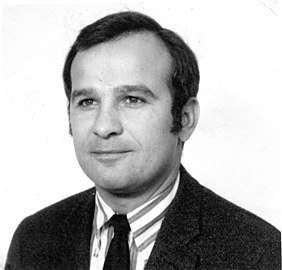Thomas Stockham
| Thomas Stockham | |
|---|---|
 | |
| Born | December 22, 1933 |
| Died | January 6, 2004 (aged 70) |
| Residence | United States |
| Nationality | American |
| Fields | Electrical engineering |
| Institutions |
Soundstream University of Utah |
| Alma mater | MIT |
| Doctoral students |
Raphael Rom Olivier Faugeras |
| Notable awards | Grammy |
Thomas Greenway Stockham (December 22, 1933 – January 6, 2004) was an American scientist who developed one of the first practical digital audio recording systems, and pioneered techniques for digital audio recording and processing as well.
Professor Stockham was born in Passaic, New Jersey. Stockham attended Montclair Kimberley Academy, graduating in the class of 1951.[1] Known as the "father of digital recording", he earned an Sc.D. degree from the Massachusetts Institute of Technology in 1959 and was appointed Assistant Professor of Electrical Engineering. Early in his academic career at MIT, Stockham worked closely with Amar Bose, founder of Bose Corporation, on the use of digital computers for measurement and simulation of room acoustics and for audio recording and enhancement. While at MIT, he noticed several of the students using an MIT Lincoln Laboratory TX-0 mainframe computer installed at the campus to record their voices digitally into the computer's memory, using a microphone and a loudspeaker connected to an A/D-D/A converter attached to the TX-0. This expensive tape recorder led Stockham to his own digital audio experiments on this same computer in 1962.
In 1968 he left MIT for the University of Utah, and in 1975 founded Soundstream, Inc. The company developed a 16-bit digital audio recording system using a 16-track Honeywell instrumentation tape recorder as a transport, connected to digital audio recording and playback hardware of Stockham's design. It ran at a sampling rate of 50 kHz, as opposed to the audio CD sampling rate of 44.1 kHz.
Soundstream Inc. was the first commercial digital recording company in the United States, located in Salt Lake City. Stockham was the first to make a commercial digital recording, using his own Soundstream recorder in 1976 at the Santa Fe Opera. In 1980, Soundstream merged with the Digital Recording Company (DRC) and became DRC/Soundstream.
Stockham played a key role in the digital restoration of Enrico Caruso recordings, described in a 1975 IEEE paper.[2] These recordings were the first to be digitally restored by computer, and were released on the album Caruso - A Legendary Performer, issued in 1976 by RCA Records.
In 1974 he investigated President Richard Nixon's White House tapes. It was he who discovered that the 18 minutes of erasures were not accidental, as Nixon's secretary Rosemary Woods claimed. Stockham was able to discern several distinct erasures and even determined the order of erasure.
Stockham's developments and contributions to digital audio paved the way for later digital audio technologies, such as the audio compact disc and DAT (Digital Audio Tape).
Stockham received wide recognition for his pioneering contributions to digital audio. He received, among many others, the Gold Medal award from the Audio Engineering Society, a Technical Emmy award in 1988, the Poniatoff Gold Medal from the Society of Motion Picture and Television Engineers,[3] a Grammy award from NARAS in 1994, the IEEE Jack S. Kilby Signal Processing Medal in 1998[4] and a Scientific and Engineering award from the Academy of Motion Picture Arts and Sciences in 1999.[5]
References
- ↑ "Alumni Awards". Montclair Kimberley Academy. Retrieved 2011-03-06.
- ↑ Stockham, T.G. ,Jr.; Cannon, T.M.; Ingebretsen, R.B. (April 1975). "Blind deconvolution through Digital Signal Processing". Proceedings of the IEEE. 63: 678–692. doi:10.1109/proc.1975.9800.
- ↑ Schoenherr, Steven E. "Tom Stockham and Digital Audio Recording". Audio Engineering Society. Retrieved 2012-09-10.
- ↑ "IEEE Jack S. Kilby Signal Processing Medal Recipients" (pdf). IEEE. Retrieved 2011-02-27.
- ↑ Ingebretsen, Robert B.; Stockham, Thomas G., Jr. (March 1984). "Random-Access Editing of Digital Audio". Journal of the Audio Engineering Society. 32 (3): 114–122.
External links
- Hammack, William S. (2004). "Thomas Stockham (Public radio commentary)".
- "Thomas_G._Stockham". IEEE Global History Network. IEEE.
- Kirk, Andrew (12 January 2004). "Thomas Stockham Jr. remembered for achievements – A pioneer in digital technology". Daily Utah Chronicle.
- "Expensive Tape Recorder". Hacks. tixo.org.
- An article on Soundstream and the introduction of commercial digital recording in the United States
- Website for Sam Katz's documentary, "Stockham"
- "Genesis: Tom Stockham, The Father Of Digital Audio Recording" (video)